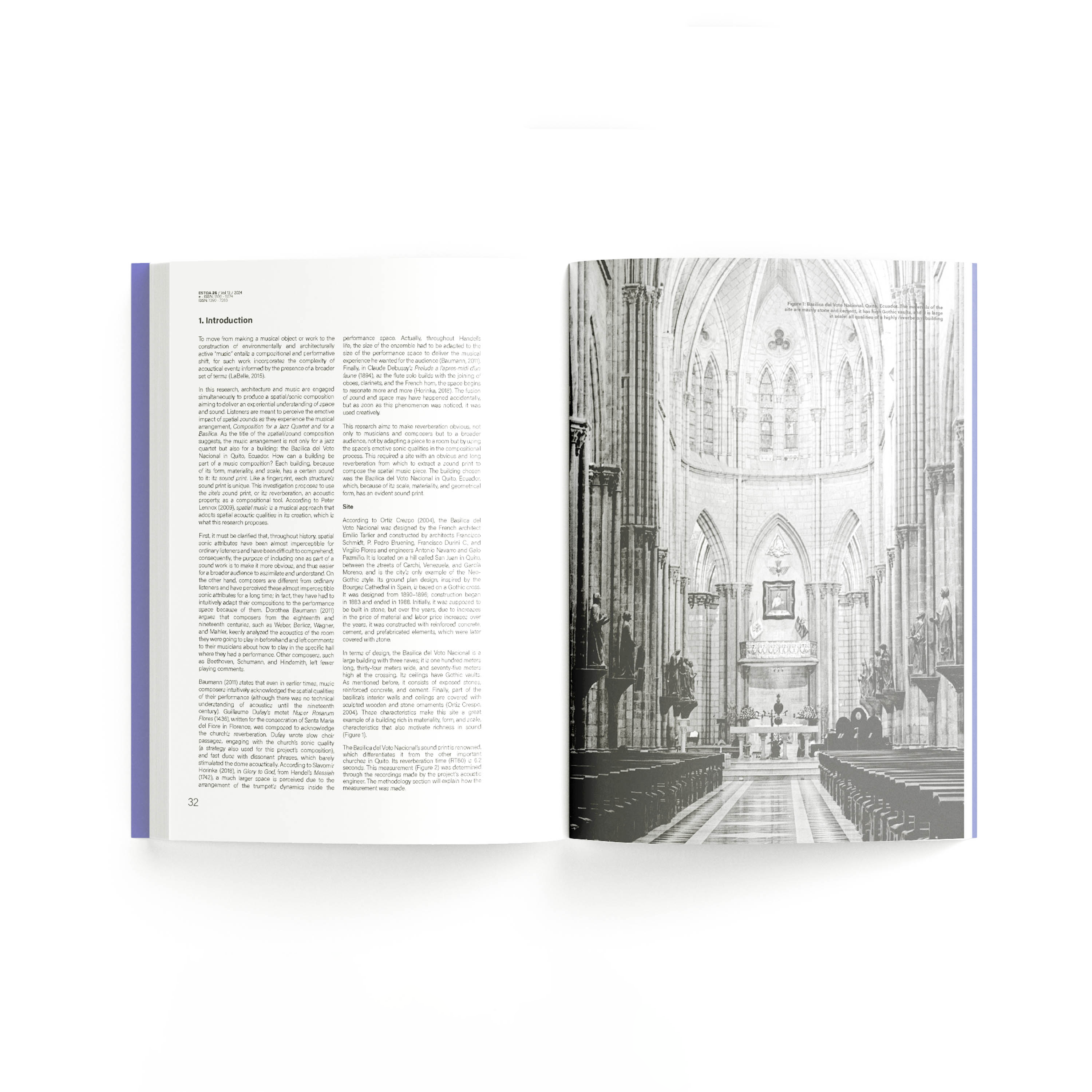Sound and Space as Compositional Tools: Using the Reverberation of a Basilica as part of a Musical Composition
DOI:
https://doi.org/10.18537/est.v013.n026.a02Keywords:
architecture, reverberation, site-specific, sound art, spatial musicAbstract
Classical composers such as Wagner, Mahler, Handel, and Debussy, among others, noticed that a space’s acoustic qualities affected their compositions, so they made intuitive arrangements to their performances to suit the space. Some contemporary musicians, on the other hand, incorporate those sonic characteristics as part of their composition. Pauline Oliveros, John Butcher, and Paul Bavister are some composers who produce site-specific works, compositions that include the site’s sound as part of their sound works. This project proposes site stimulation as a methodology to extract Basilica del Voto Nacional’s reverberation, a neo-gothic church in Quito, Ecuador, to produce a site-specific sound work: Composition for a Jazz Quartet and for a Basilica. This research aims not only to use spatial sonic qualities for music composition but also to propose a friendly, day-to-day activity, such as listening to music, as a learning method to acknowledge spatial sound phenomena.
Downloads
References
Augoyard, J., & Torgue, H. (2005). Sonic experience: A guide to everyday sounds. McGill-Queen’s University Press.
Baumann, D. (2011). Music and space: A systematic and historical investigation into the impact of architectural acoustics on performance practice followed by a study of Handel’s Messiah. Peter Lang.
Bavister, P. (2022, April 29). Audialsense. Issuu. https://issuu.com/bartlettarchucl/docs/design-research-bavister-audialsense-04
Bavister, P. (2023a, September 11–15). Biometrically evolved site-specific music as a response to localised acoustic conditions [Conference presentation]. Forum Acusticum 2023, Turin, Italy. http://dx.doi.org/10.61782/fa.2023.0306
Bavister, P. (2023b). Biometric evolution of space. Proceedings of the Institute of Acoustics, 45(2). http://dx.doi.org/10.25144/16031
Blesser, B., & Salter, L.-R. (2007). Spaces speak, are you listening? Experiencing aural architecture. MIT Press.
Bourriaud, N. (2006). Relational aesthetics. In C. Bishop (Ed.), Participation (pp. 160–171). Whitechapel.
Broomer, S. (2009). Ezz-thetics. John Butcher. https://johnbutcher.org.uk/downloads/Resonant%20Spaces%20-%20Ezz-thetics.pdf
Horinka, S. (2020). Changing the scale of perception: A composer’s view on spatial composition strategies and the spiritual aspect of music. In I. Moody (Ed.), Enlightenment & illumination: Essays on sacred music east and west (pp. 221–243). https://www.researchgate.net/publication/378862232_Changing_the_Scale_of_Perception_A_Composer’s_View_on_Spatial_Composition_Strategies_and_the_Spiritual_Aspect_of_Music
Krauss, R. (1983). Sculpture in the expanded field. In H. Foster (Ed.), Postmodern culture (pp. 31–42). Pluto.
Kwon, M. (2002). Genealogy of site specificity. In M. Kwon (Ed.), One place after another: Site-specific art and locational identity (pp. 11–31). MIT Press.
LaBelle, B. (2015). Background noise: Perspectives on sound art. Bloomsbury Academic.
Lennox, P. (2009, September). The emotional contents of the “space” in spatial music [Conference presentation]. International Conference on Music and Emotion, Durham, UK. https://www.academia.edu/10686872/The_emotional_contents_of_the_space_in_spatial_music
Oliveros, P. (1995). Acoustic and virtual space as a dynamic element of music. Leonardo Music Journal, 5, 19–22. https://doi.org/10.2307/1513156
Ortiz Crespo, A. (2004). Ciudad de Quito: Guía de arquitectura [Quito City: Architecture Guide]. Municipio del Distrito Metropolitano de Quito.

Downloads
Published
How to Cite
Issue
Section
License
Copyright (c) 2024 Estoa. Journal of the Faculty of Architecture and Urbanism

This work is licensed under a Creative Commons Attribution-NonCommercial-ShareAlike 4.0 International License.
The Journal declines any responsibility for possible conflicts derived from the authorship of the works that are published in it.
The University of Cuenca in Ecuador conserves the patrimonial rights (copyright) of the published works and will favor the reuse of the same ones, these can be: copy, use, diffuse, transmit and expose publicly.
Unless otherwise indicated, all contents of the electronic edition are distributed under a Creative Commons Attribution-NonCommercial-ShareAlike 4.0 International License.



